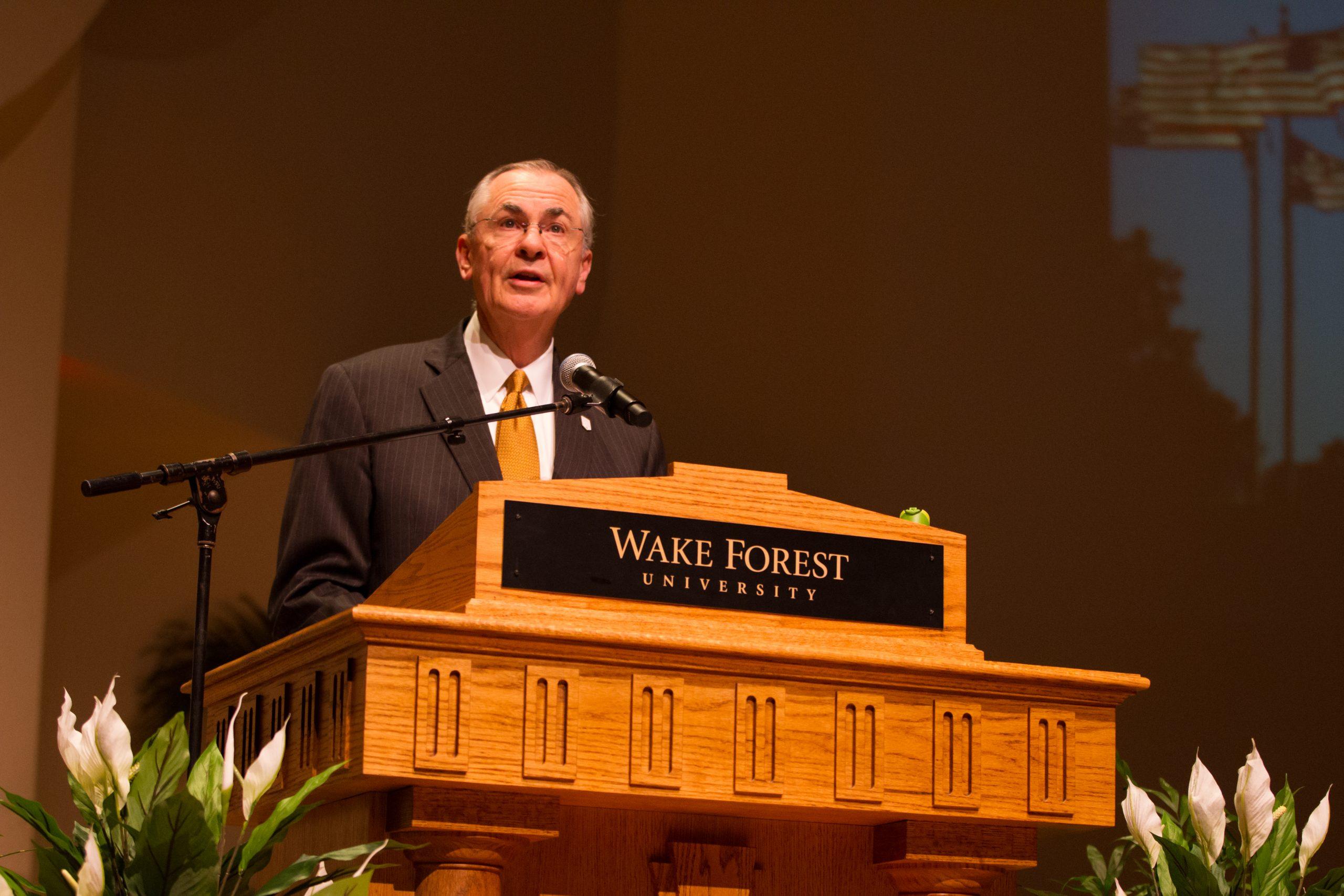At the beginning of his 2017 State of the University Address on Nov. 7, President Nathan O. Hatch observed, “Thomas Edison, a man who held more than a thousand patents, once noted that we often miss opportunity because it is dressed in overalls and looks like work.”
Affectionately referring to the university as “Work Forest,” he spent the next 40 minutes expanding on the opportunities that Wake Forest has acquired in the previous year and the work that will be required to achieve them.
Hatch cited the opening of Wake Downtown at the Innovation Quarter and its new facilities, programs and faculty as one of the most important initiatives of late and an example of university momentum. One out of every 10 students — approximately 508 undergraduates — is currently enrolled in courses in 11 subjects at the newly renovated, state-of-the-art learning space.
Furthermore, this fall the university launched its first engineering program since the 19th century, which Hatch noted was unusual, due to its combination of engineering and the liberal arts in the context of the biomedical sciences. Forty percent of the inaugural entering class is female, compared to a national average of 20 percent.
Hatch moved on to review the expanding academic opportunities for Wake Forest students beyond Winston-Salem. The Wake Washington Center, a nucleus of activity for Wake Foresters in the nation’s capital, was inaugurated this fall. The physical building, located at 1 Dupont Circle, is owned by the American Council of Education, which Hatch called the “education Vatican.” “We’ve created a place in Washington because we know it’s where our students and alumni want to be, and it’s where we think Wake Forest ought to be,” he said.
The academic Wake Washington program also began this fall, directed by politics professor Katy Harriger. A cohort of 16 students are currently spending the semester taking classes on subjects such as constitutional law and participating in a wide range of internships in the city. They have had conversations with NBC journalist Andrea Mitchell, civil rights activist Vernon Jordan, Wall Street Journal writer Shane Harris, former Congresswoman Donna Edwards and former secretary of state Madeleine Albright.
In addition, Hatch discussed Wake Forest’s “global aWAKEnings”: most notably, this fall marked the first year of a a yearlong study abroad program in Copenhagen, Denmark. A cohort of 17 first-year students, led by sociology professor Saylor Breckenridge, are currently spending the year engaging in expert guest lectures and faculty-led study tours across Europe, including to other Wake Forest study abroad locations including, London, Vienna and Venice.
As the Wake Forest academic experience grows off-campus, Hatch emphasized the importance of continuing to improve opportunities and facilities on campus. Salem Hall, the 60-year-old chemistry building, is currently undergoing an extensive renovation. Hatch said that by next year, teaching and research laboratory space in Salem will resemble spaces at Wake Downtown.
This fall is also the first semester that Reynolds Gym was open following its extensive renovation. Hatch cited it as an example of the university’s commitment to holistic student well-being. More than 3,400 undergraduate students used it during the first month, and data has shown that more than 80,000 people, including students, faculty, visitors and members of the community, have passed through its doors. The final phase of the gym expansion is due to be completed this spring and will include an aquatics center.
Hatch also discussed the efforts that the university has taken to become more cognizant of its impact on the environment. “Progress has been made … to integrate sustainability into our collective thinking,” he said. Some examples of recent initiatives, many of which have been led by the Office of Sustainability, include low-flow features that have increased water saving by 45 percent. Eight buildings on campus have silver or gold LEED certifications, Residence Life & Housing has repurposed wood for old dorm beds and a bike-sharing program is gaining speed.
Finally, Hatch discussed the university’s successful capital campaign, Wake Will Lead, which was charged with raising $1 billion by 2020. In the past fiscal year, it received $80 million, which was $20 million more than the previous fiscal year and second best in the university’s history. Wake Will Lead has received $114 million in new commitments, and the university recently learned that Porter Byrum left $70 million in his estate for financial aid.
“President Hatch’s address brought into perspective the staggering growth and change that our campus has seen over the last few semesters,” said senior Clay Hamilton.







